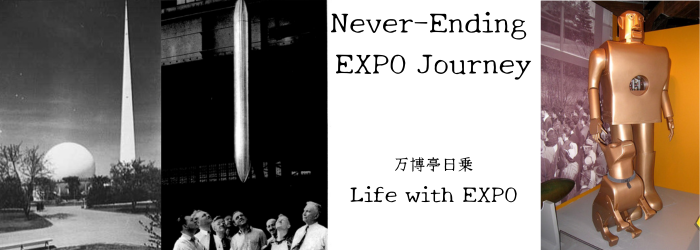Discovered “Collection of Works by Uchida Yoshikazu”!
I introduced UchidaYoshikazu (1885-1972) in episode <40>.
After the Great Kanto Earthquake of 1923, he designed many of the buildings on the University of Tokyo campus (both Hongo and Komaba) that still remain today, using the results of his research into earthquake-resistant and fire-resistant architecture, and later, he served as the president of the University of Tokyo.
He was also an “Expo-related person,” having designed the Japan Pavilion for the 1939/40 New York World’s Fair and the 1939/40 San Francisco World’s Fair (Golden Gate International Exposition) held in the same year.
In fact, when you search online bookstores, you won’t find many books about Uchida Yoshikazu.
I was wondering if there were any useful materials, and when I was touring the “Former Public Health Institute”(currently the ”Minato City Local History Museum”), I stumbled upon a very important and useful material.

東京大学医科学研究所1号館
Building 1, The Institute of Medical Science, The University of Tokyo
That is;
“Collection of Works by Uchida Yoshikazu” (hereinafter referred to as “Collection of Works”)
This is a large, thick book.
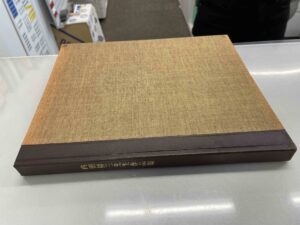
内田祥三先生作品集
Collection of works by Uchida Yoshikazu
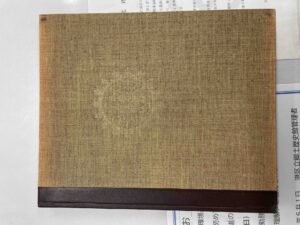
内田祥三先生作品集表紙
Cover of Collection of works by Uchida Yoshikazu
This was published by Uchida Yoshikazu’s students as an organization called “Publication Organization of Uchida Yoshikazu’s Works to Celebrate His Long-Life Span,” and this book is not for sale.
The publication date is November 30, 1969.
It was published in 1969, three years before Uchida’s death.
The “Preface” on page 9 reads as follows:
*
Normally
Especially from people close to me
I was presented this book
On the collection of architectural works by myself
Which I’ve always wanted to keep at an occasion
This book is very gorgeous
Edited and published by truly wonderful works
I would like to express my heartfelt gratitude to all the members.
Uchida Yoshikazu
*
Since Uchida Yoshikazu himself wrote the “Preface,” it seems safe to assume that this “Collection of Works” includes all of Uchida’s works.
What is generally said to be Uchida’s last work is the “Yasuda Fire & Marine Headquarters Building” (currently the Sompo Japan Headquarters Building) located in Shinjuku, Tokyo. This building was completed in 1976, so it was completed after Uchida’s death.
This “Yasuda Fire & Marine Headquarters Building” is not included in this “Collection of Works,” but it can be assumed that all the buildings before it are included.
Looking at this collection of works, it becomes clear that many of the buildings I was unaware of were designed by Uchida Yoshikazu.
It has already been more than 40 years since I was a student at the University of Tokyo, but now, through my research on the Expo, I have come across Uchida Yoshikazu and discovered that the facilities I had spent time at, without my knowledge.
Now, I learned that it was designed by someone associated with the World’s Fair.
Life is wonderful.
At that time, there was no internet, and it was difficult to research designers of the buildings on campus.
Nowadays, many things can be found on the internet at once.
As a result, there are many new discoveries.
Although it includes personal memories and experiences, I feel a strange connection.
The University of Tokyo is roughly divided into the Hongo Campus and the Komaba Campus.
Of course, there are many other campuses as well.
However, since I spent some time there, I would like to introduce you to Hongo Campus and Komaba Campus.
University of Tokyo Hongo Campus
This time, we will start with the Hongo campus.
In fact, many of the buildings on the Hongo campus are related to Uchida Yoshikazu, but I would like to introduce some of the most representative ones below, including ones that I am personally interested in.
“Tokyo University Auditorium” (commonly known as “Yasuda Auditorium”) Completed in 1925 (Taisho 14)
The first thing that is featured on the Hongo campus designed by Uchida Yoshikazu is the Yasuda Auditorium (named in the collection of works, the University of Tokyo Auditorium). It was completed in 1925 (Taisho 14).
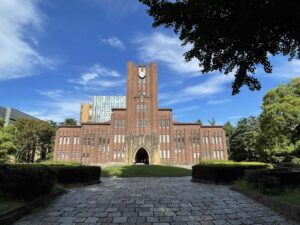
安田講堂(「東大大講堂」)
Yasuda Auditorium (“Tokyo University Auditorium”)
In 1923, the Great Kanto Earthquake occurred, and many buildings on the University of Tokyo campus were destroyed.
New school buildings were built since then.
This auditorium was completed two years after the earthquake, which is quite fast.
According to documents, the University of Tokyo Faculty of Engineering Building No. 2 was completed in 1924, and the University of Tokyo Auditorium (Yasuda Auditorium) was completed in 1925, making it the second fastest building on the University of Tokyo campus after the earthquake.
However, it is still too early.
After doing some research, I discovered that this “University of Tokyo Auditorium” had been planned before the earthquake.
Mr. Yasuda Zenjiro heard that the Emperor attended the graduation ceremony of the University of Tokyo at that time, but there was no formal version of the entrance hall.
So Yasuda decided to contribute 1 million Yen to prepare it.
Uchida, who was working on the University of Tokyo’s Faculty of Engineering Building No. 2 at the time, was recognized for his achievements, and in 1922, one year before the earthquake, he was appointed as the “Director of the Architecture Department of the Great Auditorium Architecture Department”. (This also means that the University of Tokyo Faculty of Engineering Building No. 2, which was completed in 1924, had been also planned before the earthquake.)
Construction began on December 25, 1922, the year before the earthquake, and was completed on June 30, 1925.
Along the way, the Great Kanto Earthquake occurred. Since the structural calculations at that time were from before the earthquake, Uchida thought that he wanted to build something more durable based on the experience of this earthquake, so he negotiated with the Yasuda Zaibatsu to increase the donation amount, and an additional 200,000 yen was donated as the result of his efforts.
“ The University of Tokyo Library” Completed in 1928 (Showa 3)
Next, “The University of Tokyo Library” is considered to be Uchida Yoshikazu’s most representative work.
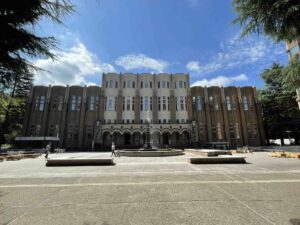
東京大学総合図書館
General Library, The University of Tokyo
According to the explanation in front of the entrance to the Hongo General Library, it says as follows.
*
The General Library was built in 1928 based on the design by Uchida Yoshikazu, professor of engineering (later president).
The old library was completely destroyed by fire of the Great Kanto Earthquake on September 1, 1923, and its collection of 700,000 books was also lost. The library had included books inherited from Tokyo Kaisei School, the predecessor of the University of Tokyo, and the Medical School, and schools from the former Shogunate era.
It contained valuable materials.
For the reconstruction of the general library, John Rockefeller Jr. donated 4 million yen. This amount is estimated to be 10 billion yen in today’s value. In addition, the League of Nations adopted a resolution to assist in the reconstruction of the library’s collection, and we received numerous donations of books from both Japan and abroad.
The Rockefeller Foundation also supported the subsequent large-scale renovations, which continue to this day. (Bold text is by the author, same below)
*
Speaking of Rockefeller, his foundation also donated more than $3.5 million to the Japanese government to the “Former Institute of Public Health,” which was introduced in <40>.
I had no idea that Rockefeller had donated so much to the University of Tokyo, not only while I was a student, but until today.
I think it was simply a grateful offer, but it seems that there was actually a lot of discussion about whether or not to accept the donation from Rockefeller.
“Collection of Works” includes the following:
*
Immediately after the earthquake, the rumor that Mr. Rockefeller was planning to donate a library to the University of Tokyo was only a rumor from my point of view (author’s note: Professor Uchida Yoshikazu). However, it was not until after the construction of the Great Auditorium (author’s note: Yasuda Auditorium) that it became concrete. It seems that Professor Masaharu Anezaki, who became the first library director, and Professor Kenzo Takayanagi, who became the second library director, negotiated with Mr. Rockefeller. However, there were also opinions within the university that did not approve of aid from foreigners.
However, he recalls that Mr. Rockefeller’s letter requesting a donation was extremely humble. “Japan will, of course, be able to restore the University of Tokyo’s library to its full glory on its own.I have no doubt in my mind. However, I would be very honored if I were allowed to add some of my own pocket money to that effort. This means “I am grateful for this,” and it is said that this softened the feelings of those who opposed it, and led to its realization. It seems that the money was his personal money, not the foundation’s.
*
So, thanks to Rockefeller’s donation, this library was completed.
The “front facade, which looks like a bookshelf lined with books,” was very well received. I see, I haven’t thought of it that way for over 40 years, but when I heard it, it’s strange because it starts to look like “bookshelf lined with books.”
Inside the library, there are reliefs of Shinkai Takezo, giving it the feel of a Tokyo University library. I feel like I should have made more use of it when I was a student. It’s a shame now.
“Tokyo University Sports Facility Annex Building” Completed in 1933 (Showa 8)
Unlike the library, I used this facility quite a bit. I have many memories.
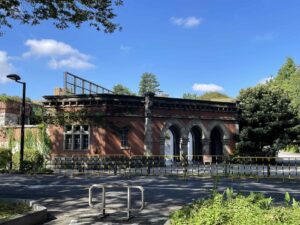
御殿下グラウンド
Gotenshita Ground
This is a semi-subterranean one-story building made of reinforced concrete that confines the northern edge of the so-called “Gotenshita Ground,” which is located at the bottom of the ground and a portion of the east facing the hospital.
“Collection of Works” says as follows;
“Part of the main building of the Faculty of Engineering, which was designed by Professor Tatsuno Kingo, was moved into this building by Professor Uchida and is now in use.”
Tatsuno Kingo (1854-1919) was a famous architect who was active in the Meiji to Taisho eras and designed the main building of the Bank of Japan and the Tokyo Station Marunouchi Station Building.
The location of “ The University of Tokyo Faculty of Engineering Building No. 1,” which will be described next, was originally the main building of the Faculty of Engineering during the time of the Imperial University. This was designed by Tatsuno and completed in 1888.
“Faculty of Engineering Building No. 1” Completed in 1935 (Showa 10)
The following is included in “Collection of Works”;
*
The left half of the Faculty of Engineering Building No. 1 is used by Civil Engineering Course, and the right half is used by Architecture Course. It is a building that has many fond memories for us (author’s note: Uchida Yoshikazu’s students). Concrete structure with steel reinforcement, 3 stories with basement, some 4 stories. Construction began in May 1929 and was completed in August 1935
*
As mentioned above, this location was the main building of the Faculty of Engineering during the days of Imperial University. According to the “Collection of Works”;
*
It is a famous red brick building designed by Professor Tatsuno Kingo and completed in 1888. Professor Uchida missed this building, and some of its pillars and capitals were repurposed as part of the playground facility building.
*
Along with this, a ginkgo tree was also relocated.
Let’s take a look at the “Collection of Works” again.
*
The large ginkgo tree that used to grow in the courtyard of this old building now stands in front of Building No. 1 (Faculty of Engineering). It is probably the largest and most magnificent tree on the University of Tokyo campus. The dense greenery is a place for students to relax, read, or break a sweat after exercising.
According to Professor Uchida, this tree was carefully moved to its current location over a period of three years. In other words, in the spring of the first year, half of the roots were removed, and the following year, the remaining half of the roots were removed, the roots were completely wrapped in straw, placed in the soil, and then transferred in the next year. “It’s a very careful method. It’s a nice tree, after all. Now it’s worth the effort.”
In the front garden of Building No. 1 stands a bronze statue of Dr. Josiah Conder, a benefactor of the Japanese architecture world. He came to Japan at the young age of 25 in 1877 as a teacher of architecture at the Faculty of Engineering, and made outstanding contributions to his education and practical work until his death in Tokyo in 1920. The bronze statue was unveiled in April 1923. The artist of this statue is Shinkai Taketaro.
*
Josiah Conder (1852-1920) was a British architect who came to Japan in 1877 and introduced Western architecture to Japan. Tatsuno Kingo was also a student. Conder’s works include Ueno Museum, Rokumeikan, Nikolaido, and Mitsubishi No. 1 Building.
Also, Shinkai Taketaro (1868-1927) is the uncle of Shinkai Takezo (1897-1968), who I introduced earlier, and he traveled to Europe for the 1900 Universal Exposition in Paris.
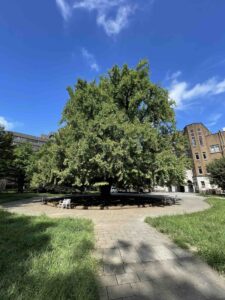
工学部一号館前の大銀杏
Large ginkgo tree in front of Faculty of Engineering Building No. 1
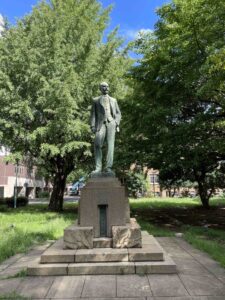
ジョサイア・コンドルの像(東大本郷キャンパス)
Josiah Conder statue (Hongo Campus of The University of Tokyo)
Tokyo University Student Hall (Nishoku ,Dining Hall 2) Completed in 1938 (Showa 13)
When I was a student, the second floor of this building, known as “Nishoku” (Dining Hall 2), housed the club room of the General Affairs Department of the University of Tokyo Athletic Association (Undokai). For some reason, the name “Undoukai” has been used historically at the University of Tokyo instead “Taiikukai”, which is usually used by many other universities.
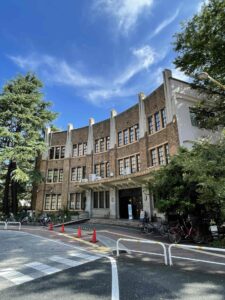
東大生協のビル
Tokyo University Co-op Building
This is a place where the author, who was a member of the General Affairs Department of the University of Tokyo Athletic Association (Undokai), visited almost every day.
At that time, I just spent my time inside this building, not knowing that it was such an important cultural asset, and not really being grateful for it.
I have many memories.
By the way, the “Tokyo University Indoor Pool” was installed on the first basement floor of this building in 1936 (Showa 11). This was two years before the ” Dining Hall 2″ building was completed. It was probably built underground first.
At that time, I had never heard of “swimming in the basement of Nishoku,” but I wonder what is going on now.
The “Collection of Works” includes the following:
*
This indoor pool is located in the basement of the building that was originally Nishoku and is currently called the student hall.
Construction of the formal pool, which is 13m wide and 25m long, began in March 1935 and was completed in April 1936.
According to the professor, “Japan’s first person to participated in Olympic swimming and won a medal” used the reservoir in the Mechanical Department of the Faculty of Engineering because there was no practice pool in the winter. This is probably because the steam was blowing in so it was warm. After seeing this, Professor Uchida decided create a formal swimming pool. At both First High School and Hongo, Professor Uchida built playgrounds for which they had no budget, by excusing he was preparing the sites. This pool may also have been referred to as an underground water tank.
*
“University of Tokyo Jukendojo” (“Shichitokudo”) Completed in 1938 (Showa 13)
Furthermore, this “Shichitokudo” was also the work of Uchida Yoshikazu.
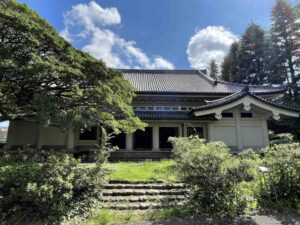
七徳堂(武道場)
Shichitoku-do (Martial arts Hall)
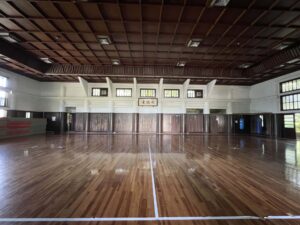
七徳堂(武道場)内部
Inside of Shichitoku-do (Martial arts Hall)
When I was a student, it was already called “Shichitokudo” instead of “Jukendojo,” and in addition to the judo and kendo clubs, the aikido club and the Shorinji Kempo club, to which I belonged, also used this building.
There are club rooms for each club on the side facing the Gotenshita ground, and I don’t know about the other clubs, but the Shorinji Kempo club room, as you might imagine (?), was not very clean, to say the least. We were using such a masterpiece of architecture and cultural property so carelessly and wastefully.
I would like to sincerely apologize to Professor Uchida Yoshikazu.
However, on this day, more than 40 years later, I realized how truly blessed I was as a student when it was common for me to spend time inside such precious buildings.
